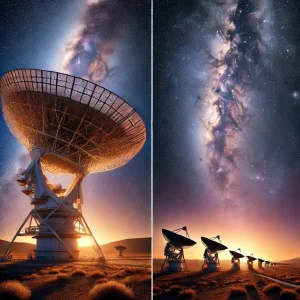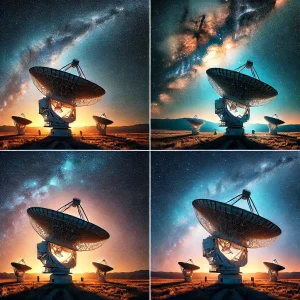The night sky has always been a source of wonder and inspiration, a tapestry of twinkling lights that beckon us to explore the mysteries of the cosmos. While our eyes can only take us so far, radio telescopes open up a whole new dimension of discovery, allowing us to delve into the hidden frequencies of the universe. This article celebrates the joy of radio telescopes and the incredible journeys they enable, bringing the cosmos closer than ever before.

Unlocking the Universe: The Magic of Radio Telescopes
Ever wondered how we can hear the whispers of the universe? Radio telescopes are the magical instruments that make this possible. Unlike optical telescopes that capture visible light, radio telescopes detect radio waves emitted by celestial objects. This gives astronomers the ability to “see” things invisible to the naked eye—unraveling secrets buried deep in the cosmos. These remarkable devices have been instrumental in discovering phenomena such as pulsars, quasars, and the cosmic microwave background radiation, which all contribute to our understanding of the universe’s origins.
One of the most fascinating aspects of radio telescopes is their sheer size and complexity. Often spanning several kilometers, arrays of radio telescopes work in unison to create images of unparalleled detail and clarity. The Very Large Array (VLA) in New Mexico and the Atacama Large Millimeter/submillimeter Array (ALMA) in Chile are prime examples of these engineering marvels. Their sprawling networks of dishes collect weak radio signals from space, combining data to reveal stunning images and groundbreaking insights about the cosmos.
But the magic doesn’t stop there. Radio telescopes have the unique ability to operate day and night, unaffected by clouds or atmospheric conditions that often hinder optical telescopes. This continuous observation window allows for more comprehensive studies of celestial phenomena, offering scientists an uninterrupted look into dynamic processes such as star formation, black hole activity, and the ever-changing behavior of galaxies. Radio telescopes truly unlock the universe in ways that optical instruments simply cannot.

Journey Beyond Stars: Adventures in Cosmic Exploration
Radio telescopes have taken us on some of the most thrilling adventures in cosmic exploration. Imagine listening to the rhythmic pulses of a distant pulsar or mapping the intricate structure of a far-off galaxy. These instruments have allowed us to venture beyond our solar system, peering into regions of space that were previously unimaginable. They have played a pivotal role in the search for extraterrestrial life, scanning the skies for signals that might indicate the presence of intelligent civilizations.
One of the most awe-inspiring adventures facilitated by radio telescopes was the discovery of cosmic microwave background radiation, the faint afterglow of the Big Bang. This discovery provided compelling evidence for the origin of the universe, giving us a glimpse into the very birth of time and space. Additionally, radio telescopes have been essential in studying the enigmatic dark matter and dark energy that make up most of the universe’s mass and energy. These explorations push the boundaries of human knowledge, continuously reshaping our understanding of the cosmos.
For amateur astronomers and space enthusiasts, radio telescopes also offer a gateway to personal cosmic adventures. Many observatories around the world engage in public outreach, offering tours and even hands-on experience with radio astronomy. Enthusiasts can join citizen science projects, contribute to real scientific research, and experience the thrill of cosmic discovery firsthand. These opportunities make the wonders of the universe accessible to everyone, fostering a community of explorers eager to unlock the secrets of the stars.
Exploring the cosmos with radio telescopes is a joyous journey into the unknown, a never-ending adventure that brings us closer to the mysteries of the universe. These remarkable instruments have revolutionized our understanding of the cosmos, unveiling hidden wonders and inviting us to dream beyond the stars. As technology advances and our curiosity continues to grow, who knows what extraordinary discoveries await us? The sky is not the limit—it’s just the beginning.









